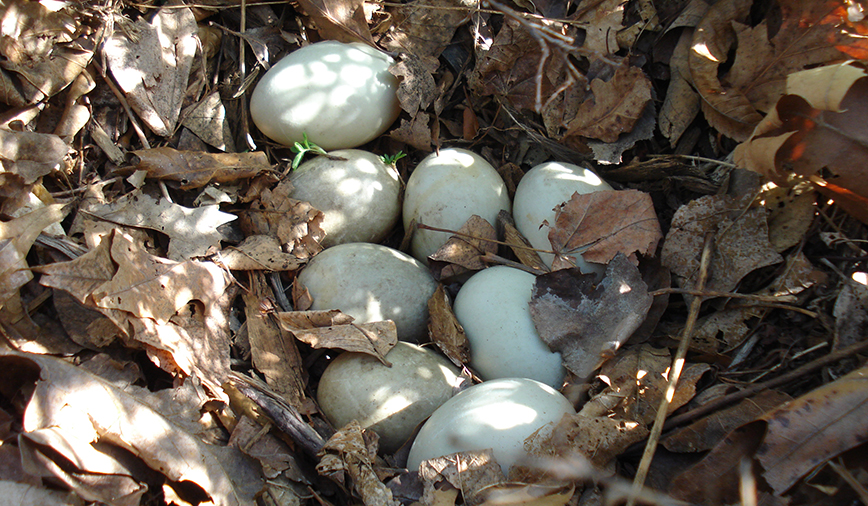St. Charles Park District Nature News – May 8
I know we weren’t supposed to, but we did it anyway. We counted our eggs before they hatched.
To make matters worse, they technically aren’t even “our” eggs.
But since they’re in “our” parking lot here at Pottawatomie, several of us on staff have felt a sense of stewardship toward these eggs, which actually belong to a duck and now total around 12. (Yeah, around, not exactly. We’re naturalists, not numbers people.)
The egg saga, a parenting story just in time for Mother’s Day, began about two and a half weeks ago. Krista, our early childhood recreation supervisor and budding nature girl (whether she realizes it or not), noticed some unusual activity in one of the parking lot islands. There in the shrubs, surrounded by asphalt, were two ducks, a male mallard and a female of a species I’ve come to call “mostly mallard.” (They’re the ducks you see on the Fox River that are dark with a white breast. David Allen Sibley in his Sibley Guide to Birds describes these domestic ducks as having “…a bewildering variety of plumages and sizes…”)
Anyway, the pair was positioned in the wood chips in the parking lot island, with the male in a slight depression and the female standing nearby. It looked for all the world like he was the one excavating the nest depression, and she was supervising—even though all the books say the female assumes all nesting responsibilities.
Regardless, once the depression was complete, the two switched places and Mom went to work. After a short period of time, both left the area. They returned the next day, and the day after that, and that’s when we stepped in. There in the “dent” (it really didn’t look at all like a nest yet), hidden under a sycamore leaf, sat one, no, two, greenish-gray eggs.
The activity took on a predictable pattern. The duck couple would come to the parking lot early in the morning, Krista and her son would see them, then we’d go back and count the eggs after the birds flew away. Each day brought one more egg until we reached a total of 12, more or less.
This past work week found Mom alone on the nest, surrounded by a circle of fluff— down feathers pulled from her own breast. Dad was nowhere to be found; he’d flown the coop, which is standard operating procedure for ducks. (Once the last egg is laid, males form single-gender flocks and generally avoid nest areas completely. Human moms, insert your comments here: _______.)
Today marks day six, more or less (again, we’re not numbers people) of the incubation process. It takes an average of 28 days, or a range of 26 to 30 days, for the eggs to hatch. And when they do, look out—a pretty amazing thing occurs.
Whereas many bird species hatch their eggs asynchronously—that is, not at the same time—ducks and several other species don’t begin incubating their eggs until the last one has been laid. This practice helps ensure that all the eggs hatch within a few hours of each other.
Snap, crackle, pop! If all goes well, in about three weeks “our” duck will go from egg tender to mother of 12 (more or less) in a matter of hours.
Until then, we’re going to have to bide our time—and cross our fingers. A year ago another mallard nested here at Pottawatomie but met a rather unfortunate fate at the hands (or paws) of some local raccoons.
We’ll keep you posted on how this nest attempt progresses. If mom duck is able to avoid predation, molestation, or any of the other –ations that befall nesting birds, we’ll watch and see how many ducklings march off with mom toward the boat ramp and their new life on the Fox River. By our count, there should be 12…more or less.
Pam Otto is the manager of nature programs and interpretive services for the St. Charles Park District. She can be reached at potto@stcparks.org or 630-513-4346.

